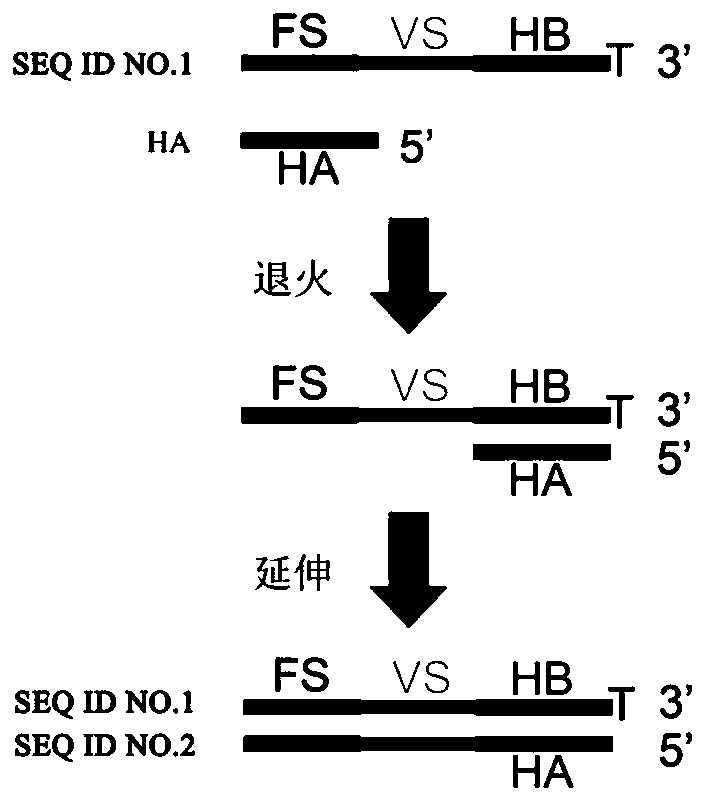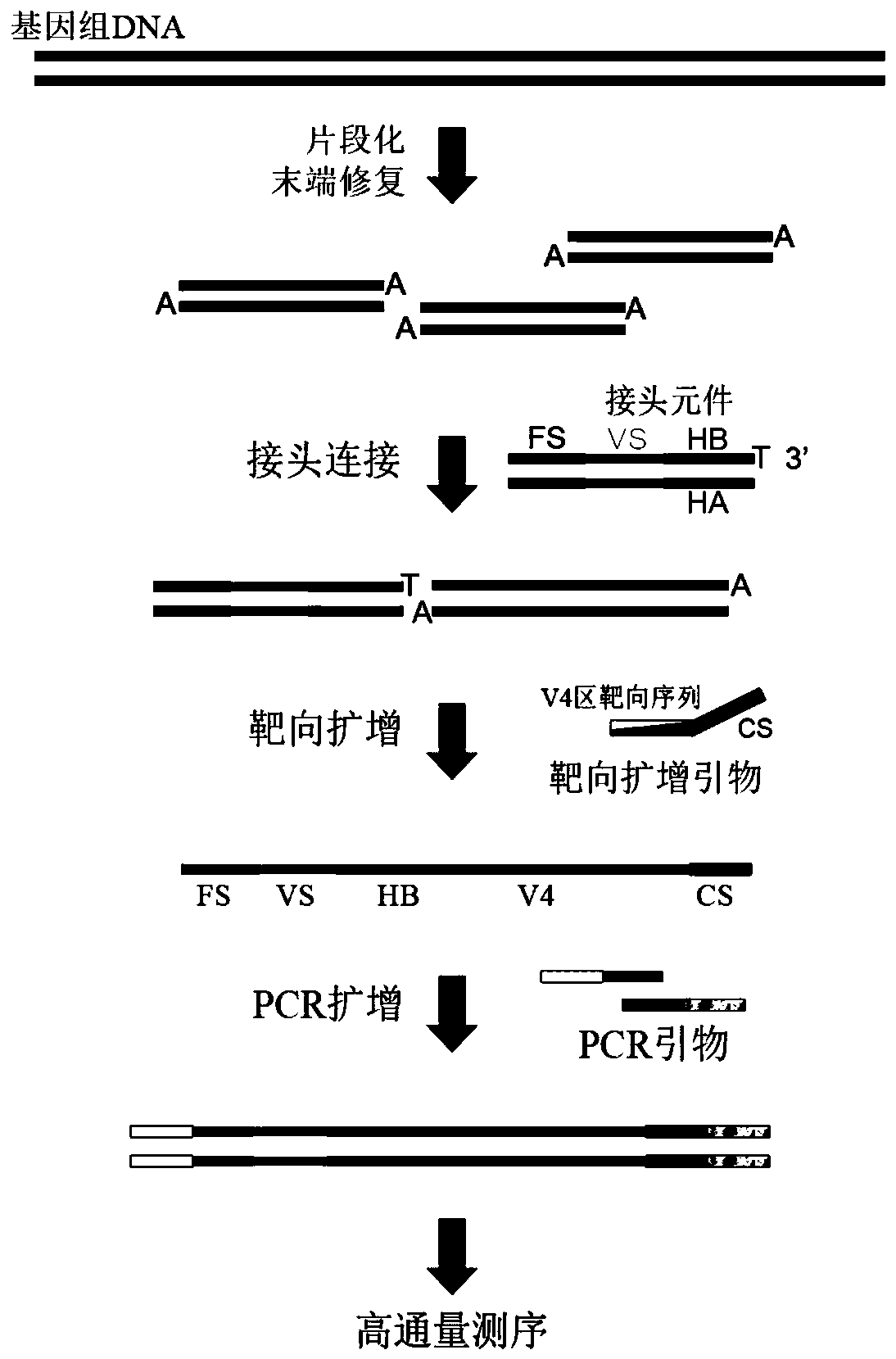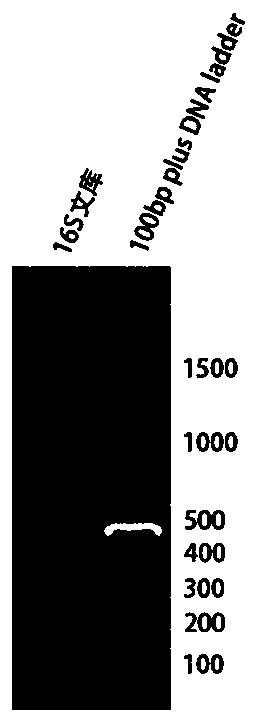Joint element for 16S rDNA variable-zone quantitative sequencing library construction and library construction method
A technology of adapter components and sequencing libraries, applied in the field of high-throughput sequencing, can solve the problems of inability to identify bacterial strains, inability to accurately quantitatively analyze bacterial abundance, and inability to remove sequencing errors, so as to improve sequencing accuracy, avoid detection distortion, The effect of improving classification accuracy
- Summary
- Abstract
- Description
- Claims
- Application Information
AI Technical Summary
Problems solved by technology
Method used
Image
Examples
Embodiment 1
[0052] The features and advantages of the present invention can be further understood from the following detailed description in conjunction with the accompanying drawings. The examples provided are merely illustrative of the methods of the present invention, and are not intended to limit the remainder of the present disclosure in any way. [Example 1] Design of adapter elements, specific targeted amplification primers, and PCR amplification primers required for the construction of 16S rDNA V4 region quantitative sequencing library
[0053] 1. One of the sequences of the linker element SEQ ID NO.1: (5'→3')GTTCAGAGTTCTACAGTCCGACGATCNNNNNNNNNNNCACTGGATACACT, wherein the italicized part is a fixed sequence FS, NNNNNNNNNN represents a variable sequence, which is composed of randomly arranged nucleotides, and N is Any base in A, T, C, G, N at different positions is the same or different base; the bold part is the hinge sequence HB; the 3' end is a protruding base T. Sequence of the...
Embodiment 2
[0070] [Example 2] 16S rDNA variable region quantitative sequencing library construction and construction process as follows figure 2 shown.
[0071] S1: Metagenomic DNA Fragmentation
[0072] 1 μg of the extracted metagenomic DNA was taken and subjected to ultrasonic fragmentation treatment (ultrasonic apparatus: Ningbo Xinzhi, JY92-IIN); 750W, 20% power, 1s ON, 1s OFF, ultrasonic for 8min.
[0073] S2: DNA end repair
[0074] Add a phosphate group at the 5' end, and add adenine A at the 3' end;
[0075] Prepare the following system:
[0076] component
Volume (μL)
End Rep mix (Vazyme, ND604-01)
7.5
Interrupted metagenomic DNA
7.4(100ng)
ddH 2 O
17.6
total
32.5
[0077] Perform the following reactions in a PCR machine
[0078] Temp
Time
20℃
30min
65℃
30min
4℃
hold
[0079] S3: Connector connection
[0080] The linker element prepared in Example 1 was ligated wit...
Embodiment 3
[0109] [Example 3] Sequencing data analysis
[0110] S1: Split the sample according to the index sequence of the sample to obtain the sequence of a single sample;
[0111] S2: Quality control of raw data to remove low-quality bases;
[0112] S3: Cluster the sequences of reads for each sample based on variable sequences (eg Figure 4 , 5 shown). Case 1: If the variable sequence VS is the same and the other partial sequences have only mismatches of less than or equal to 4 bases, then cluster all these reads into a cluster, where the number of identical reads is greater than In half of the cases, it is used as the unique sequence (unique sequence) of the cluster, and in other cases, the bases are corrected according to the base quality value to obtain the unique sequence; Case 2: If the variable sequence VS is the same and other partial sequences have more than 4 bases The mismatch of the base will be clustered into different clusters, and the sequence will be retained as the...
PUM
 Login to View More
Login to View More Abstract
Description
Claims
Application Information
 Login to View More
Login to View More - R&D
- Intellectual Property
- Life Sciences
- Materials
- Tech Scout
- Unparalleled Data Quality
- Higher Quality Content
- 60% Fewer Hallucinations
Browse by: Latest US Patents, China's latest patents, Technical Efficacy Thesaurus, Application Domain, Technology Topic, Popular Technical Reports.
© 2025 PatSnap. All rights reserved.Legal|Privacy policy|Modern Slavery Act Transparency Statement|Sitemap|About US| Contact US: help@patsnap.com



